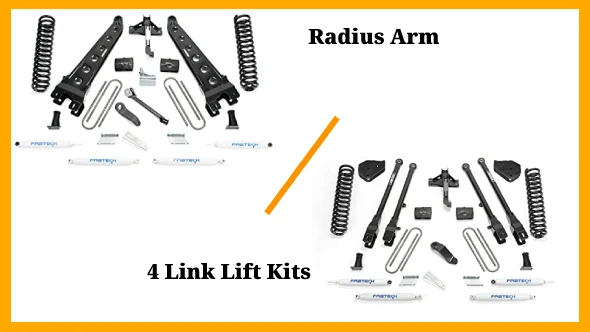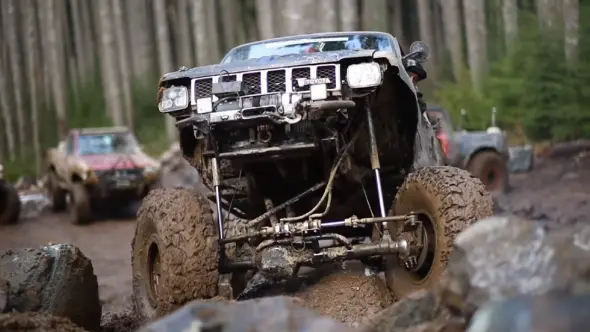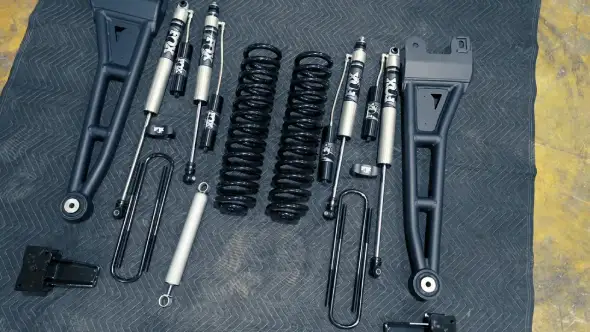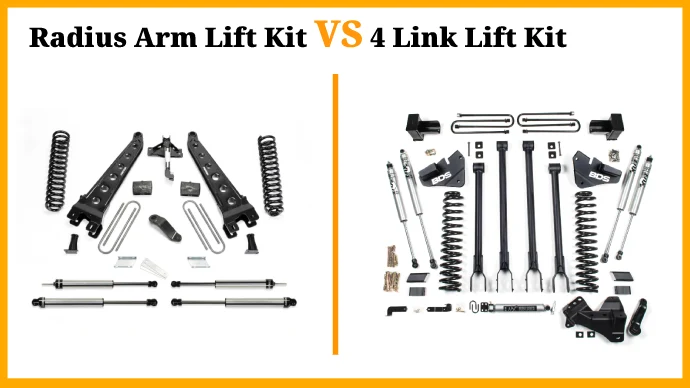Last Updated on March 12, 2023
Radius arm and 4-link lift kits are two popular options for upgrading your vehicle’s suspension system. Each one has its advantages and disadvantages, so it’s important to understand the differences between them before deciding which one is right for you.
The main distinguishing factor between the two systems is that a radius arm system uses one link per side of the axle, while a 4-link system uses two links per side.
Also, each link in a radius arm system has two mounting points, while a 4-link system has four mounting points.
Installation of a 4-link lift kit may be more time-consuming due to its complex design, and it also tends to be more costly than radius arm lift kits.
Ready to take your lift kit knowledge up a notch? We’re here to help you decide between the radius arm and 4 link kits, complete with all the differences.
Radius Arm vs 4 Link Lift Kits: Make the Right Choice

Nothing screams off-roading like a lifted ride. Two popular suspension systems to make it happen are the radius arm lift kit and the 4-link lift kit. But what’s the difference? Check out this breakdown of these two mad methods of taking your vehicle up, up, and away:
1. Design
The primary point of differentiation within the radius arm and 4 link lift kits lies in their respective designs. Primarily, radius arms have two mounting points, one for each side of the axle, whereas a 4 link system uses four per side.
Thus, installing 4 link lift kits requires more parts and bolts to be secured than a radius arm setup. Depending on the model and make of your vehicle, further fabrication or welding may be required for the successful installation of the 4-link kit.
2. Stability
The radius arm system is praised for its stability and control at higher speeds due to its design that limits the movement of the axle. This reduces body roll and helps keep the vehicle more stable when cornering or taking sharp turns.
On the other hand, a 4-link lift kit is designed for greater articulation and flexibility for off-road applications.
While this provides an advantage in rougher terrain, it does come with the tradeoff of sacrificing some stability on roads compared to a radius arm lift kit.
3. Articulation
Regarding suspension articulation, 4 link lift kits are a superior choice compared to radius arm lift kits. This is because the radius arm design has fewer points of contact with the axle, limiting possible movement.
Conversely, 4 link lift kits have four separate links that can provide a more comprehensive range of movement and better adjust to uneven terrain conditions.
They offer greater suspension travel while helping keep all four wheels in contact with the ground for improved traction. With these advantages, 4 link lift kits are typically the best choice for optimal suspension articulation.
4. Cost
Radius arm lift kits are usually more cost-effective than 4-link lift kits because they require fewer parts. The components of radius arm lift kits are typically less expensive and easier to source than the more complex 4-link kits.
Aside from that, 4-link systems tend to be more labor-intensive and may require additional modifications such as welding or custom fabrication, which can add to the overall cost.
5. Installation
Installing a radius arm lift kit is generally simpler compared to a 4-link lift kit. While radius arms can be installed using the factory mounting points on a vehicle, 4-link lifts often require additional modifications such as custom fabrication or welding.
Also, 4 link lifts require an alignment after installation, whereas radius arms may not need an alignment depending on the specific kit used. As a result, the installation process for a radius arm lift tends to be faster and easier than that of a 4-link kit.
6. Weight
Radius arm lift kits are generally lighter than 4 link lift kits, making them the go-to choice for vehicles that need to reduce overall weight. This is due to the fact that radius arm lifts require fewer components and less fabrication, resulting in a lighter final product.
On the other hand, 4 link lift kits can be heavier, as they involve more complex components and fabrication.
Because of their additional parts and moving components, 4 link lift kits are usually bulkier than their radius arm counterparts, something to consider if you don’t want too much bulkiness added to your vehicle.
7. Durability
The durability of both the 4 link lift kits and radius arm can be high if they are installed correctly. But, the additional components and moving parts of a 4-link lift kit can ultimately lead to more wear and tear over time due to increased stress and strain.
As such, while both types may offer similar performance levels initially, in the long run, a radius arm lift kit is likely to provide greater reliability.
8. Steering
Radius arm lift kits are designed to keep the factory steering geometry, meaning it maintains the steering feel and handling of how it was before the lift kit was installed.
Conversely, 4 link lift kits require some modifications to the steering system in order to keep proper alignment and handling.
The main difference between a radius arm and a 4-link is that with a radius arm lift kit, your suspension is limited in its range of motion. Because of the arms connecting at one point on the axle.
While 4-link setups allow for greater articulation and flexibility on uneven terrain because of four separate points where the arms connect to the axle.
9. Maintenance
Radius arm lift kits tend to require less maintenance than 4 link kits due to their simpler design.
They mainly consist of two arms connecting the axle with the frame at each end, whereas 4 link lift kits feature four separate links that need to be inspected and adjusted regularly.
Regular lubrication is recommended for all components in order to ensure proper operation and reduce wear on parts over time.
While both types of lifts generally require periodic inspection and maintenance, 4 links will demand more frequent attention due to its additional components and moving parts.
10. Off-road performance
Regarding off-road performance, 4-link lift kits are generally considered superior due to their ability to provide more articulation and flexibility than radius arm lift kits. This allows for greater stability and control when driving over rough terrain or off-road trails.
However, it’s important to note that even when using a radius arm lift kit, you can still get good off-road ride quality if you use high-quality components and ensure everything is properly set up for optimal performance.
Which Is Better 4 Link or Radius Arm?

A 4-link suspension system is often considered to be better than a radius arm setup for off-roading. The main reason for this is that it provides more articulation and flexibility, allowing the vehicle to move more easily over uneven terrain.
Also, the 4-link system has independent suspension points that can be tuned to provide greater stability and handling when going over obstacles or traversing steep inclines. The downside of a 4-link system is that it’s significantly more expensive and complex to install than a radius arm setup.
The radius arm system is much simpler and less expensive to install, making it ideal if you are on a budget or don’t have the time to tackle a major upgrade.
This type of suspension also offers good handling capabilities but may not be as capable as a 4-link with regard to articulation.
If you aren’t planning on doing hardcore wheeling all of the time, then this type of setup may be preferable due to its affordability and ease of installation.
Whether you should go for a radius arm or 4-link suspension depends largely on your budget and intended usage for your vehicle.
If you are looking for improved performance over rough terrain and don’t mind spending extra money, then the 4-link system could be worth considering.
Alternatively, if you want an affordable solution that’s easy to install and still provides good performance in everyday use, then the radius arm setup could be the better option for you.
Can a Radius Arm or 4-Link Lift Kit Be Used on Any Type of Vehicle?
Both radius arm and 4-link suspension systems can be used on a variety of vehicles, including trucks, SUVs, and off-road vehicles.
Still, the specific design and configuration of the suspension system will depend on the make and model of the vehicle, as well as the intended use.
Some vehicles may be better suited for one type of suspension system over the other. For example, a 4-link system is generally preferred for off-road use, as it provides better articulation and traction control. A radius arm system may be more suitable for on-road use or moderate off-roading.
Radius Arm Versus 4 Link Lift Kit – Which Offers Good Cornering Performance?

Regarding cornering performance, a 4-link lift kit is often preferable over a radius arm lift kit. This is because a radius arm lift kit utilizes a long arm that connects to the frame and the axle.
This restricts the amount of movement the axle can make, resulting in reduced articulation and stiffness in the suspension. It does not offer as much mobility when it comes to navigating corners.
A 4-link lift kit solves this issue as it consists of four separate links that connect the axle to the frame. This provides more suspension flexibility and articulation, allowing for better cornering traction and stability.
In general, this superior performance makes a 4-link lift kit the more attractive option when compared to radius arm lift kits.
Upgrade Your Suspension: Deciding Between a 4 Link vs Radius Arm Lift Kit
When choosing between a radius arm and 4 link lift kit for your suspension upgrade needs, it’s important to understand their key differences.
The 4 link system provides better stability and control over the axle due to its four mounting points. However, it can be more costly and take longer to install due to its complexity.
On the other hand, although the radius arm system only has two mounting points per side, it is usually easier to install and less expensive than its counterpart. Therefore, depending on your car’s needs and preferences, either option could be suitable for you.
